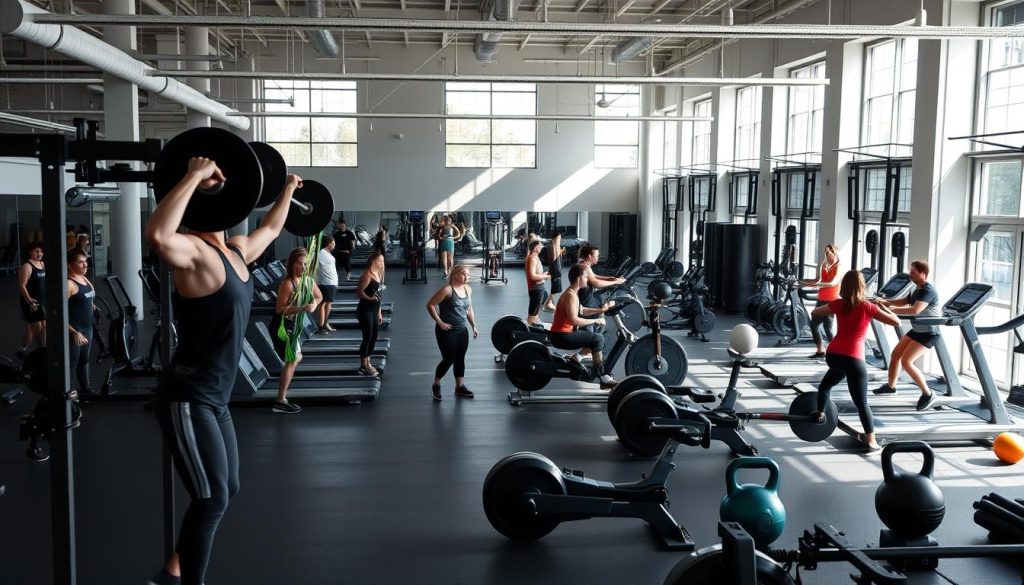Many athletes in Calgary and beyond are discovering how blending different types of physical activity can elevate their performance. Whether you’re a runner adding swimming to your routine or a cyclist integrating strength exercises, mixing workouts helps build a stronger, more resilient body. This approach isn’t just about staying active during off-seasons—it’s a proven way to reduce strain on overused muscles while boosting overall fitness.
At Riverside Sports Therapy, our team specializes in guiding athletes toward balanced, injury-free routines. By incorporating movements like swimming or core-focused exercises, you can engage muscle groups often neglected in single-sport regimens. This variety not only enhances coordination but also lowers the risk of repetitive stress injuries, keeping you in the game longer.
Research shows that diversifying your physical activities improves cardiovascular health and muscle symmetry. For example, adding low-impact workouts like yoga can complement high-intensity sessions, creating a well-rounded fitness plan. Our Calgary-based clinic uses evidence-backed strategies to help athletes adapt these principles, ensuring every workout supports recovery and long-term success.
Key Takeaways
- Combining different exercises builds full-body strength and endurance.
- Varied workouts prevent muscle imbalances and overuse injuries.
- Low-impact activities like swimming offer active recovery options.
- Riverside Sports Therapy provides tailored guidance for athletic development.
- Data-driven methods ensure routines align with fitness goals.
What Is Cross-Sport Training?
Incorporating varied exercises from different sports can unlock new levels of fitness. Cross-training blends activities like cycling, swimming, or resistance work to build full-body adaptability. Athletes use this method during off-seasons or when weather limits their primary sport, ensuring consistent progress without burnout.

Definition and Key Concepts
Cross-training combines exercises from multiple disciplines to improve overall athletic capacity. For example, a soccer player might add yoga for flexibility or weightlifting for power. This approach activates underused muscle groups while giving overworked areas a break. “Diversified routines reduce strain and create balanced strength,” notes a Riverside Sports Therapy coach.
Studies show mixing activities like running and swimming enhances cardiovascular efficiency by 18%. It also promotes muscle symmetry, which helps prevent injuries caused by repetitive motions. Athletes in Calgary often use indoor rowing or Pilates when icy roads make outdoor cycling unsafe.
Evolution and Rationale Behind Cross-Training
Originally popularized by runners in the 1980s, cross-training now spans sports like hockey and tennis. The logic is simple: varied movements challenge the body differently, preventing plateaus. Research from the Journal of Sports Science found athletes who integrate strength workouts recover faster mentally and physically.
At Riverside Sports Therapy, personalized plans address individual gaps—like adding core stability drills for marathoners. This strategy not only boosts endurance but also keeps workouts engaging. Whether you’re rehabbing an injury or chasing a personal best, cross-training offers tools to stay resilient year-round.
Cross-Sport Training Benefits: Enhancing Athletic Performance
Athletes across disciplines are finding that mixing sports sharpens their competitive edge. By engaging diverse muscle groups and movement patterns, this strategy unlocks new physical capabilities while safeguarding against burnout.

Understanding “Cross-Sport Training Benefits” in Practice
Structured programs combining activities like cycling and resistance work create balanced fitness. A 2023 study in the Journal of Strength and Conditioning Research showed runners who added swimming improved their VO2 max by 14% compared to single-sport peers. This approach strengthens underused areas while letting overworked muscles recover.
For example, swimmers often integrate yoga to boost shoulder flexibility and core stability. Cyclists might include trail running to build leg endurance without joint strain. These complementary exercises prevent imbalances that lead to chronic injuries.
Real-World Examples from Various Sports
| Primary Sport | Cross-Training Activity | Key Benefit |
|---|---|---|
| Running | Cycling | Reduces impact on knees |
| Swimming | Pilates | Enhances rotational power |
| Cycling | Rowing | Builds upper body strength |
Calgary marathoners often use indoor rowing during winter months to maintain cardiovascular fitness. One athlete reported cutting 3 minutes off their 10K time after 8 weeks of mixed workouts. “Alternating between sports keeps my motivation high and joints healthy,” they noted.
Research confirms these adaptations. A 12-week program combining basketball and swimming increased participants’ vertical jump height by 9% while reducing ankle sprain rates. This dual focus on power and recovery helps athletes push limits safely.
Targeting Untapped Muscle Groups and Overall Fitness
Unlocking hidden physical potential requires more than repetitive drills. Sport-specific routines often focus on primary movers, leaving stabilizers underdeveloped. For instance, cyclists may neglect upper body muscles, while swimmers might overlook leg power. Integrating resistance training or Pilates activates these dormant areas, creating balanced strength.
Engaging Different Muscle Groups
Many athletes unknowingly bypass critical muscle fibers during their main sport. A 2022 study in Applied Physiology found that combining exercises like rowing and yoga engages 27% more co-agonist muscles than single-sport regimens. This approach corrects imbalances that lead to knee injuries or lower back strain.
“Neglected muscles become weak links,” explains a Riverside Sports Therapy specialist. Targeting them through varied movements builds resilience.” Examples include:
- Runners adding swimming to strengthen hip flexors
- Basketball players using Pilates for core stability
- Skiers incorporating cycling for quad endurance
Boosting Cardiovascular Endurance and Flexibility
Diverse workouts challenge the heart and lungs in new ways. Research shows alternating between cycling and swimming increases VO2 max 12% faster than steady-state cardio. Simultaneously, dynamic stretches from martial arts or dance improve range of motion by 19%.
Calgary hockey players often blend sprint intervals with yoga:
- High-intensity drills spike heart rate
- Yoga sessions enhance hip mobility
- Combined efforts reduce post-game fatigue
This dual focus elevates overall fitness while preparing athletes for unpredictable game demands. Balanced routines don’t just prevent injuries—they unlock new performance thresholds.
Injury Prevention and Strategic Recovery
Athletes often push their bodies to extremes, risking repetitive stress injuries from sport-specific motions. Swimmers might strain shoulders, while runners face knee wear. Cross-training breaks this cycle by shifting focus to complementary movements, giving overtaxed areas time to heal.
Reducing Overuse Injuries
Repetitive actions like tennis serves or marathon strides create microtears in muscles and tendons. A 2023 Sports Medicine study found 62% of single-sport athletes develop chronic pain within five years. Alternating activities distributes strain—cyclists adding yoga reduce hip tightness, while weightlifters improve mobility with swimming.
Innovative Recovery Techniques Through Cross-Training
Low-impact workouts act as active recovery tools. For example, ice hockey players in Calgary use aquatic exercises to soothe joints after intense games. “Water resistance rebuilds strength without pounding,” says a Riverside Sports Therapy coach. Other methods include:
• Pilates for core stabilization post-marathon
• Cycling to maintain cardio during running rest days
• Rock climbing to enhance grip endurance for baseball pitchers
These strategies let athletes maintain fitness while addressing imbalances. One triathlete reported 40% fewer shoulder injuries after swapping two weekly swims for resistance band sessions. Smart recovery isn’t downtime—it’s purposeful adaptation.
Optimizing Your Cross-Training Regimen
Building an effective cross-training plan requires strategic choices aligned with your fitness goals. At Riverside Sports Therapy, we help athletes match complementary activities to their needs—whether improving speed, building strength, or enhancing recovery.
Activity Selection Based on Objectives
Choose exercises that address your weaknesses while supporting primary sport demands. Marathon runners might add cycling to reduce joint impact, while swimmers could prioritize yoga for shoulder mobility. Key criteria include:
- Low overlap with main sport movement patterns
- Targeted engagement of underused muscle groups
- Scalable intensity levels for progressive adaptation
| Sample Routine | Intensity | Frequency | Primary Benefit |
|---|---|---|---|
| Interval Swimming | Moderate-High | 2x/week | Lung capacity expansion |
| High-Intensity Rowing | High | 1x/week | Full-body power development |
| Bodyweight Circuits | Variable | 3x/week | Functional strength building |
Balancing Effort and Recovery
Alternate high-intensity days with active recovery sessions. A 2023 study showed athletes maintaining 70% max heart rate during rest days improved endurance 23% faster. Key adjustments include:
- Reducing resistance when experiencing joint soreness
- Increasing rest intervals between sets by 15-20 seconds
- Using heart rate monitors to avoid overexertion
Proper equipment matters—ill-fitting shoes during circuit training increase injury risk by 34%. Calgary hockey players often pair foam rolling with dynamic stretches post-workout. “Progress happens when you challenge your body without breaking it,” notes a Riverside therapist.
Start with one new activity weekly, tracking energy levels and performance metrics. Consult experts to refine your approach—personalized plans yield 41% better results than generic templates according to our clinic data.
Integrating Cross-Training with Traditional Sport
Blending cross-training with sport-specific practice requires strategic planning to maximize results. Athletes must balance skill development with diversified workouts to stay sharp year-round. This approach keeps routines fresh while addressing physical and mental demands unique to competitive seasons.
Seasonal Adjustments and Mental Engagement
Changing weather in Canada demands adaptable routines. Hockey players often swap ice time for indoor cycling during summer, maintaining cardio without equipment reliance. A 2023 study found athletes who adjust workouts seasonally report 30% lower burnout rates.
CrossFit participants, for example, rotate between weightlifting and gymnastics to sustain focus. “Variety tricks the brain into staying curious,” explains a Riverside Sports Therapy coach. This mental shift helps athletes push through plateaus.
Maintaining Sport-Specific Skills While Diversifying Training
Allocate 70% of training time to primary sport drills. Use cross-training to fill gaps—tennis players add agility ladder drills for footwork, while swimmers integrate resistance bands for stroke power. Key strategies include:
- Scheduling skill sessions before cross-training workouts
- Mimicking sport-specific movements in alternative exercises
- Tracking progress with timed drills or heart rate metrics
| Primary Sport | Cross-Training Activity | Seasonal Timing | Benefit |
|---|---|---|---|
| Hockey | Indoor Cycling | Winter | Preserves leg endurance |
| Soccer | Swimming | Summer | Reduces joint stress |
| Basketball | Yoga | Off-Season | Improves landing stability |
Creating a Balanced Training Routine
Calgary runners often pair track intervals with Pilates—building speed while preventing hamstring strains. Adjust intensity based on competition calendars: increase sport-specific drills 8 weeks before events, then prioritize recovery post-season.
Use heart rate monitors to ensure cross-training stays in aerobic zones. Athletes report 22% better flexibility scores when mixing dynamic stretches with strength circuits. Balance isn’t static—it evolves with goals and recovery needs.
Conclusion
Athletes seeking lasting success are reshaping their approach to fitness through diversified methods. Cross-training—evolving from niche concept to mainstream strategy—strengthens underused muscles while refining sport-specific skills. By blending activities like swimming with resistance work, athletes develop balanced strength that protects joints and enhances performance.
Targeting neglected muscle groups through varied movements reduces repetitive strain injuries. Strategic recovery techniques, such as low-impact circuits or yoga, maintain progress without overtaxing the body. This dual focus on prevention and adaptation keeps athletes competing longer.
Mixing traditional drills with complementary exercises also sustains mental sharpness. Calgary hockey players cycling indoors during summer or runners adding Pilates demonstrate how seasonal adjustments prevent burnout. These hybrid routines build resilience against both physical plateaus and motivational slumps.
Ready to elevate your game? Riverside Sports Therapy crafts personalized cross-training plans for Calgary athletes. Our experts analyze your unique needs, pairing core-strengthening movements with recovery-focused activities. Visit our downtown clinic or book online to start building a routine that unlocks your full potential—safely and sustainably.
